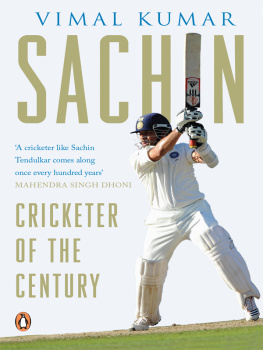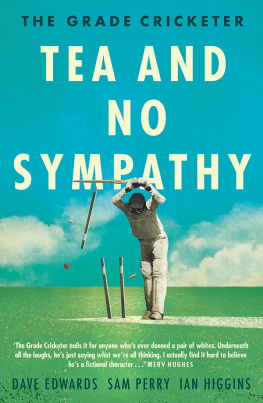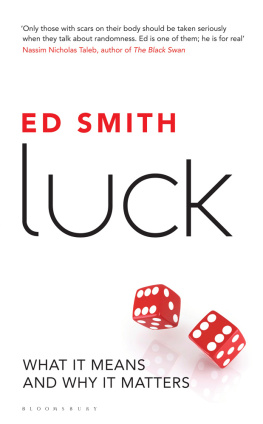


First published by Pitch Publishing, 2014
Pitch Publishing
A2 Yeoman Gate
Yeoman Way
Durrington
BN13 3QZ
www.pitchpublishing.co.uk
Andrew Murtagh, 2014
All rights reserved. No part of this book may be reproduced, sold or utilised in any form or transmitted in any form or by any means, electronic or mechanical, including photocopying, recording or by any information storage and retrieval system, without prior permission in writing from the Publisher.
A CIP catalogue record is available for this book from the
British Library.
ISBN 978-1-909626-24-9
eBook conversion by eBookPartnership.com
Contents
Foreword
by Sir Michael Parkinson
O ld men forget, but not everything. We have a secret hoard of memories stored like golden guineas which the passing years cannot contaminate.
If I close my eyes and think of all I have seen in a lifetime of playing and watching cricket, I see Fred Trueman bowling to Tom Graveney at New Road, Worcestershire, in 1962. Tom had just qualified for the home county and he celebrated the move by scoring 1,539 runs at an average of 48.09. At the same time, playing for England against the Pakistan tourists, he scored 401 runs at an average of 100.25. In the same season Fred Trueman was Englands main wicket-taker in Tests with 22 at under 20 each and in county cricket 106 wickets at 17.82.
But statistics are not why I remember that day. It was the perfect setting for Tom Graveney. His elegance at the crease and his languid strokeplay deserved the setting of cathedral and river. And Fred, for all the fire and brimstone of his personality, had an action of such purity and grace that watching him bowling and Tom batting in that setting was a never-to-be-forgotten sight. Tom batted better than Fred bowled and his 80-odd on a seaming wicket was a masterpiece.
Twenty years later and Tom Graveney, now in his 60s and long retired, came to my local cricket club at Bray in Berkshire. His son Tim was first-team captain and we were having a fun game to raise funds. Tom sportingly agreed to turn up and venture into the middle although he had not played for a good number of years. I was umpiring as he took guard and hoped our first bowler, a tearaway from Australia, might have enough sense to give Tom a courtesy one off the mark. At it was he came charging in at full tilt and bowled a quick bouncer which Tom swayed away from and then gave the bowler what is often described as an old-fashioned look.
A further bouncer followed but this time Tom moved forward and inside the line and flicked the ball into the adjoining churchyard for six. The next ball went even further into the gravestones and when the bowler pitched up Tom unfurled (there is no other way to describe it) a cover drive of such grace and elegance he should have been wearing a powdered wig and silk knee breeches.
At the end of the over our bowler said, Jeez, the old bugger can bat. Who is he?
Tom Graveney, I said.
It meant nothing.
Who did he play for? asked the bowler.
Gloucester, Worcestershire and England, I said.
I cannot repeat the Aussies reply.
If I analyse my most lasting memories of cricket they all feature players of graceful manner. Tom Graveney in full flow was effortless and unfeigned. There were no curlicues or flourishes. The beauty of his play was its simplicity, its lack of vanity. What you learn about style is it cant be taught. Those who try look like frauds. Those who possess such a gift simply cant help it.
Andrew Murtagh has written Toms story with thorough research and sympathetic understanding of a man who was often misunderstood and sometimes controversial except in one regard: everyone agreed he was a batsman of unique style, and not the kind of cricketer who fades from memory.
Preface
I saw Tom Graveney bat once. I wonder how many times that observation has been made the length and breadth of the cricketing world. I have heard it often enough during the course of writing this book. And the odd thing is that it is usually accompanied by a glazing over of the eyes and a settling of the facial expression into a warm glow of nostalgia, rather like the recollection of a pleasant meal, together with a nice bottle of wine, during a particularly intense holiday romance.
Clearly, to the transfixed onlookers, a Graveney innings was much more than the sum of its parts. It transcended the number of runs that he had scored, even the context of the match in which it had been played. Frequently the teller of the anecdote was hazy about the exact details of the game itself It was against the Australians in 1956or was it the West Indies in 1957? Anyway, he was batting at Lordsoh, hang on a minute, was it the Oval? Never mind what I remember is the cover drive for four
Sport can do this to you. A moment of supreme skill, matchless artistry, breathtaking athleticism and surpassing grace can make you blink in disbelief and the memory of it stays with you forever.
Can it therefore be taken as read that a thing of transient beauty can be more important than the result of the game? Can a delicate chip over the goalkeeper, an outrageous dummy by a wing three-quarter, a cross-court bullet of a backhand take on any the more or less significance if the match is lost?
The long-suffering fan, ardent for success, would say no. But the two elements the artistic and the prosaic do not have to be mutually exclusive. Kelly Holmes, when she won Olympic gold in the 1,500 metres in Beijing in 2008, seemed to be floating effortlessly over the track while her competitors huffed and puffed and went backwards. The Spanish football team won the World Cup by simply passing the ball to each other, weaving intricate patterns all over the pitch, while their opponents chased shadows. Roger Federer is like liquid as he moves around the court, producing elegant winners, barely breaking sweat.
It is said that Tom Graveney never played an ugly stroke. A rash one perhaps, or a false one, or even not one at all, but never one that offended the eye. The trouble is that when a stylish batsman gets out playing a languid shot, he is accused of being loose and failing to concentrate. Whereas, if the stroke results in the ball being caressed to the boundary, a collective sigh of appreciation goes up from the spectators, who turn to each other and say, Did you see that?
A batsman of more recent vintage but of similar gracefulness to Tom Graveney was David Gower. He suffered from the same sort of criticism in his career, that he was too nonchalant at times, but he always had his answer ready. I scored 8,231 Test runs, he would retort. So I must have been doing something right. Toms response to the charge that he was too carefree for the rigours of Test cricket is not so pointed but equally pertinent. I scored a few, he grinned. And I didnt bat too badly, did I?
I should say so. By a few, he meant 47,793 first-class runs, with 122 centuries. Of course, bald statistics do not tell the whole story. In Tom Graveneys case, it is not just the runs on the board, nor the numbers in the record books, which cricket lovers prefer to remember, but the manner in which he made them.
Next page













